
Of all of the different components of the practical test, the one that seems to strike the most fear into the hearts of learners is the reversing manoeuvre they'll need to complete. One of these is bay parking—both forward and reverse. If you're still a bit unsure about the bay parking manoeuvre, we've got just what you need.
In this guide, we're going to look at the bay parking manoeuvre: how to perform it, what the examiner is looking for and when it might be used in real-life conditions.
What is bay parking?
Added to the driving test in December 2017, the bay parking manoeuvre is probably one of the most important manoeuvres you'll need to learn—considering you'll need to be able use car parks on a day-to-day basis. As such, it's absolutely vital that you get to grips with it.
There are two types of bay parking, so you could be asked to demonstrate either on your test:
- Forward bay parking: in which you drive into a parking bay and then reverse out. On your test, this can be performed in any car park—including the driving test centre car park.
- Reverse bay parking: in which you reverse into a parking bay and then drive out. Your examiner will usually only ask you to do this in the driving test centre car park.
There's a 1-in-3 chance that you'll be asked to complete the bay parking manoeuvre during your practical test. The instructions will sound something like this:
Forward bay parking
“I'd like you to drive forward into any parking bay on the left or right (if the car park permits), finishing within the lines… Now I'd like you to reverse out either to the left or right (again, if the car park allows it).”
Reverse bay parking
“I'd like you to reverse back into any parking bay on the left or right (if the car park permits), finishing with the lines… Now I'd like you to drive out of the bay either to the left or right (again, if the car park allows it).”
What is the examiner looking for?
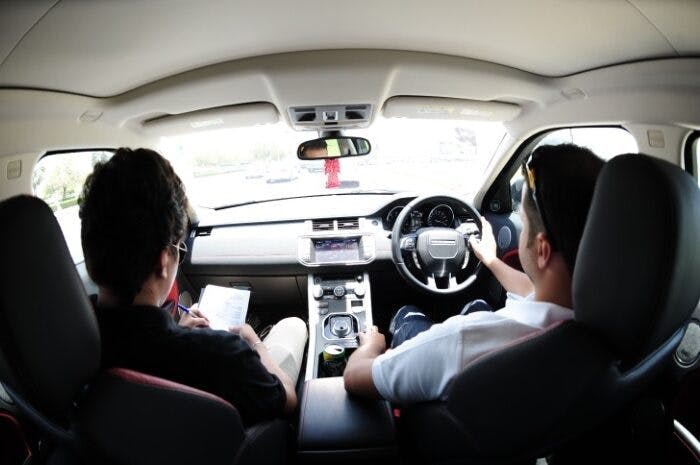
The examiner will be watching how well the candidate can control and manoeuvre the vehicle in a restricted space—carefully monitoring their use of the clutch, accelerator and handbrake. The learner will need to display good judgement with picking a parking space and positioning the vehicle. The examiner will also be keeping an eye out for the learner's observations whilst driving forward and reversing out/reversing in and driving out.
Regardless of whether you're asked to complete the forward or reverse bay parking manoeuvre, the examiner will be expecting you to demonstrate:
- All around checks and observations. Car parks attract pedestrians and a constant stream of traffic. As such, you'll need to use your MSM routines and stay aware of your surroundings.
- Good judgement throughout the manoeuvre. It's up to you to pick a suitable parking bay to accurately manoeuvre into—staying inside of the bay lines as you reverse in and drive out/drive in and reverse out.
- Control of the vehicle. You need to stay a low and controlled speed—not only because you're in a car park but also because it makes manoeuvring easier—making careful use of the clutch, accelerator and brakes.
You could pick up driving test faults during your bay parking manoeuvre for lack of control, poor observations and mediocre planning.
Bay parking pro-tip:
Candidates can't drive through a first parking bay and then park in a bay directly in front of that. Similarly, when you reverse out, you can't go into any bays behind you.
You are allowed to make adjustments throughout the manoeuvre. For example, if you're driving into a parking bay but feel like you're not quite in the lines, you can reverse and try again to correct your position.
How do I park in a bay?
Step-by-step: Forward bay parking
1. Pick a bay

The examiner will tell you to drive forward into a parking bay in the driving test centre car park or another car park of their choosing. It's entirely up to you to choose a bay. Don't panic and pick the first one you see—take your time and give yourself plenty of room to manoeuvre.
- When you enter the car park, keep an eye out for any arrows indicating a one-way system, or bays that you're not allowed to park in.
- Whilst you can pick a bay on the left or right, it's always easier to opt for the right. By doing so, you can give yourself plenty of room and avoid moving against the flow of traffic on the right.
- Depending on parking availability, you should try to pick a bay that doesn't have vehicles on either side—it will make it easier to get within the lines and make observations.
- Slow and steady does it—keep your speed down and your eye out for any pedestrians and other vehicles.
2. Start to move and find your reference point
Once you've got a bay picked out, you need to give yourself enough room to turn and make constant observations to ensure you're safe to carry out the manoeuvre.
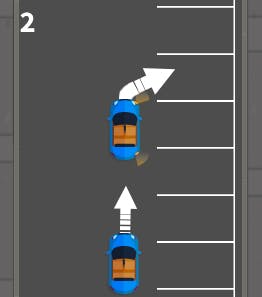
- Move over to the left as far as you can to give yourself space to turn—as long as you're not restricted in any way, such as by parked cars.
- If you're driving into a bay on the left, you'll want to move over to the right to give yourself enough room—pay attention to any oncoming traffic.
- Check your right/left-hand mirrors and your blindspot(s) for any pedestrians or vehicles, and then indicate to show your intention.
- As you move further towards your bay of choice, keep an eye out for your reference point/point of turn. Your instructor will have shown you this during your lessons. Though it depends on the car, this reference point is typically as the first line of the bay appears under your right/left-hand mirror.
Bay Parking Pro-Tip:
Not sure about the reference points in your instructor's car? It's important that you know them—get your instructor to go over them in the lesson before your practical test. If it helps, they might add a marker or tape on the dashboard to help you spot your references as you go along.
3. Steer quickly and move at a slow pace
Once you've found your reference point, you're almost ready to turn into your chosen parking bay. Remember, all-around checks are important here—don't slip up!
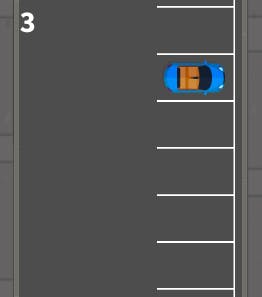
- Before you make your right/left turn, it's time to check your interior and right/left-hand mirror and blindspot. If it's clear, you're good to go. If it's not, pause and wait for the pedestrian(s) or vehicle(s) to move.
- Slowly start to move off—keeping a firm control of your clutch and accelerator—and quickly steer with a full right/left lock.
- As you turn into the bay, you need to straighten up your vehicle—it helps if you keep an eye on your dashboard and take note of when it's in line with the horizon or fence.
Stop the car once you've reached your next reference point, e.g., when the bay line reaches under your door mirror. If you're not within the lines, take your time and adjust. Once you're happy, select neutral and apply your handbrake.
4. Reverse out of the bay
Now that you're in the bay, there's only one step left in the manoeuvre: reversing out. Again, observations are important here—whilst your reverse lights should warn pedestrians of your intentions, they might simply ignore them. As such, it's your responsibility to stay aware of your surroundings.
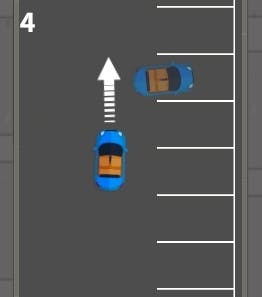
- Start by selecting the reverse gear and have your hand ready to release the handbrake. Do your all-around checks—looking at the road you'll be reversing into—and begin to slowly move out. You need to be prepared to stop at any point for other vehicles.
- Once you reach your reference point (i.e., the start of the bay line lining up with your side door), it's time to half turn your wheel to either the left or right—depending on the direction you want to drive off in.
- When you're clear of any nearby vehicles, it's time to turn your wheel full lock and stop once you've got enough room to drive off.
- Select first gear and then check your blindspot and mirrors for any other road users. Once you're clear, you're good to go and drive out of the car park.
And now onto the reverse bay parking manoeuvre...
Step-by-step: Reverse bay parking
1. Pick a bay
The examiner will tell you to reverse into a parking bay in the driving test centre car park (on rare occasions, they may decide to do this manoeuvre in a car park of their choosing). It's your choice as to which bay you reverse into. Take your surroundings into consideration as you pick—try for one that will give you plenty of room.
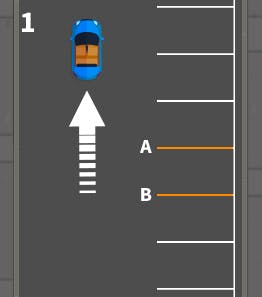
- When you're picking a parking bay, try to find one that doesn't have vehicles on either side. The more space you have, the less you've got to worry about when reversing into the bay.
- You need to position your vehicle closer to the centre of the road—this will make turning easier and give you a better chance of getting between the lines. If you're too close to the bays, you'll have less space to manoeuvre.
- Keep your speed nice and slow—not just because you're in a car park with other road users, but also because rushing often leads to mistakes.
- Once you've picked out a bay, you need to pull up around two car lengths past it and get ready to reverse to your point of turn.
2. Find your point of turn and steer quickly
You'll now have to reverse your car up to your point of turn. Although it varies with each car, this reference point is roughly found when the 3rd line from the bay you're targeting lines up with your side door.
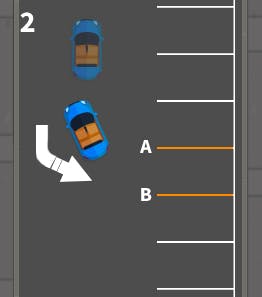
- Once you've got your point of turn lined up with the side of your door, it's time to prepare to reverse into the parking bay.
- You don't have to apply the handbrake or stop, but it does help to break up the manoeuvre and slow you down enough to maintain complete control.
- Before you even start turning to the left or right, you need to take a good look around the car park and make sure you're clear to go ahead. All-around checks are vital—don't forget your blind spots and the rear windscreen.
- When you're ready to turn, you need to steer quickly and full-lock to the left (or right, if you're reversing into a bay on the right).
3. Get into the bay and adjust
Now it's time to reverse your car into the bay and adjust as you go along to get the vehicle between the lines. Slowly does it—if you move slowly enough, you'll be able to make adjustments as you go along. If you move too quickly, you'll end up needing to drive forwards and reverse back in to make any changes.
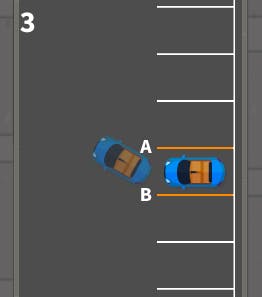
- As you're reversing into the bay, you need to keep looking around in all directions—including your blind spot and rear windows. If you encounter any pedestrians or vehicles, stop the car and wait for them to pass you by.
- Soon enough, you'll start to see the first line of the bay in your left-hand (or right-hand) mirror. Keep an eye on this—you'll be able to gauge how close or far you are.
- As you get further into the bay, the second line will begin to line up with your right-hand (or left-hand) mirror. You'll be able to tell instantly whether you're inside the lines or not.
4. Finish and move off
Now it's time to straighten up and make any necessary adjustments to get between the bay lines. Once you're ready, the examiner will tell you when you need to move off.
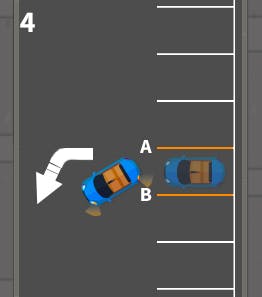
- Keep checking your side mirrors—once the bay lines are parallel, it's time for you to straighten the wheel—around one and a half turns should do it.
- A bit outside of the lines? You're allowed to make adjustments. Steer towards the line you need to get closer to, or drive forwards and reverse back in.
- Hitting the kerb is an instant fail, so keep it slow. Once you're happy, stop the car, apply your handbrake and select the neutral gear.
- When you're given the go-ahead by the examiner, you'll move to first gear, indicate to the left or right and turn the car out of the parking bay.
When are bay parks used in real life?
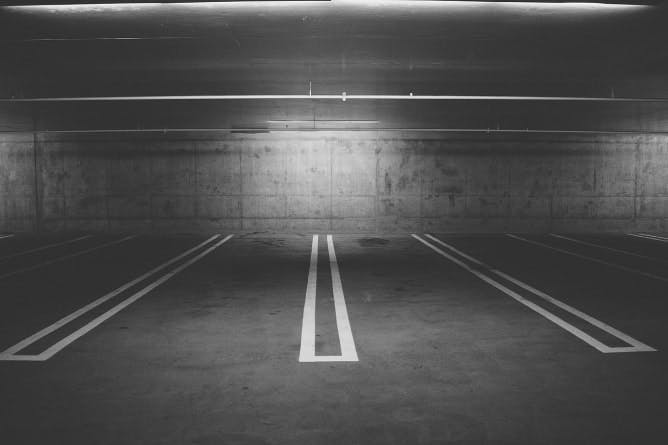
The question should really be, “When wouldn't you need to bay park in real life?”. As soon as you've got your hands on your driving licence, you'll undoubtedly be flexing your newfound skills on the roads around the UK—maybe even planning a road trip or two. An essential part of real life driving, however, is being able to park safely. Whether you're making a quick stop at your local shop or parking up at work, you need to know how to forward or reverse bay park.
If you can, you might be better off using the reverse bay park manoeuvre rather than the forward bay park. That's because driving forward out of a parking bay is usually a lot safer—and easier—than reversing out of one (though if you've mastered both, it should be a piece of cake!).
Bay Parking Guide: FAQS
Do I need to indicate when carrying out the manoeuvre?
Whilst the examiner will try to avoid car parks with heavy traffic, you're still likely to encounter other road users when performing your bay parking manoeuvre. As such, you need to take necessary precautions to ensure other road users know what you're planning to do. Indicating makes it easier for others to know which direction you're turning in.
How big is a parking space?
The recommended standard bay size is around 2.4m wide and 4.8m long. This should give you more than enough room to manoeuvre your vehicle into the bay and get your wheels relatively straight.
Why do I need to learn how to bay park?
Whether you're heading to work, popping into the shop or pretty much visiting anywhere, you'll need to use a car park. If you don't know how to bay park once you've passed your test, you'll be in for a few nasty surprises!
What are the odds I'll be asked to bay park on my test?
You've got a 1 in 3 chance of being asked to complete the bay parking manoeuvre. This means you can't just leave it to chance and hope you'll be asked to demonstrate another one—you need to make sure you're comfortable with bay parking.
What other manoeuvres are there?
Other than bay parking, there are two other manoeuvres that the examiner might ask you to demonstrate on your practical test:
- Pulling up on the right
- Parallel parking at the side of the road
Will I fail if I can't park in a bay?
Manoeuvres are an important component of the practical test. If the examiner feels like you're showing a lack of judgement or control whilst carrying out the manoeuvre, it's likely that you'll pick up a major fault—meaning you'll fail. Don't worry too much about this. Instead, remember, slow and steady wins the race—you're allowed to make adjustments if you feel like you're off by a bit.
Do I have to get the vehicle completely straight?
No. This is just one of the many driving test myths out there. Providing you have made an attempt to straighten the front wheels, the examiner won't be too concerned if the wheels aren't entirely straight. Plus, you can make adjustments along the way to straighten up if you need to.
Do I have to complete the manoeuvre in one move?
No. You're allowed to pull forward or reverse back (depending on whether you're reverse or forward bay parking) in order to correct your positioning. If it helps, you can stop the car before your point of turn in order to break up the manoeuvre into more manageable chunks.
How long do I have to complete the bay parking manoeuvre?
Whilst there isn't an exact time limit imposed, you're looking at around 4 minutes or so. In reality, you won't need this much time—you'll be done in a couple of minutes. Don't rush, though. Take your time and move slowly; it will give you a better chance of accuracy and control.
What happens if I see pedestrians or other vehicles while I am bay parking?
You need to react accordingly. Even if you perform the most controlled and perfect bay parking manoeuvre, you'll fail your driving test if you don't stay on top of your observations. If you see someone approaching you, slow down and stop—allow them to pass before you continue.
What if there a lot of a cards in the car park when I'm completing the manoeuvre?
Typically speaking, the test centre shouldn't be that busy—nor will the car park the examiner picks for the manoeuvre. If there are other vehicles, you'll have to use you own judgement. You can stop and wait for a vehicle to pass, but if there's a constant stream of traffic, you'll have to eventually get on with it. The other vehicles will have to wait for you to continue, so don't feel pressured into rushing.
Can I refuse to complete the bay parking manoeuvre?
Simply put, if you want your practical test to continue, you shouldn't refuse to complete any manoeuvre the examiner asks you to demonstrate. Feel free to ask questions if you don't understand the instructions, but bear in mind that if you simply refuse, the examiner will probably end the test then and there.
Where will I be asked to carry out the manoeuvre?
It depends on whether you're asked to demonstrate a forward or reverse bay park manoeuvre. The reverse bay park manoeuvre can only be carried out in the test centre's car park (usually, though there are exceptions to every rule), whilst the forward bay park can be undertaken at the test centre or a car park of the examiner's choosing.
What if I think I'm going to hit the kerb?
If you're concerned about hitting the kerb or finding yourself outside of the bay lines, remember, you are allowed to make adjustments. Rather than waiting for something bad to happen—picking up driving test faults—make necessary adjustments to ensure you nail the manoeuvre.
Will the examiner get out to check I'm within the lines?
It's not likely. The examiner will probably be able to tell just by using the side mirrors. Of course, if they're not entirely certain, they'll tell you that they need to get out of the car to double check.
When in the test will I be asked to perform this manoeuvre?
If you're demonstrating the bay parking manoeuvre in the test centre car park, then the examiner could ask you to do it at the beginning or end of the practical test. If, on the other hand, it's a car park of the examiner's choosing, it will likely be at any point during the independent driving section. Instead of worrying about when you'll be asked to perform a manoeuvre, just concentrate on your driving and take it a step at a time.
Subscribe for driving advice, offers & more
We'd love to let you know about our courses, news and offers via email. You may unsubscribe at any time.
Star Genie Limited trading as PassMeFast. Company number 10093359
Copyright © 2024 owned by Star Genie Limited
PassMeFast, Blue Tower, MediaCityUK, Salford, M50 2ST

